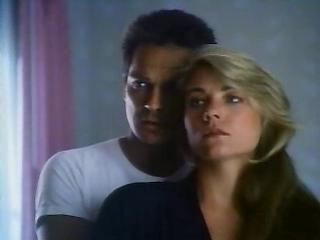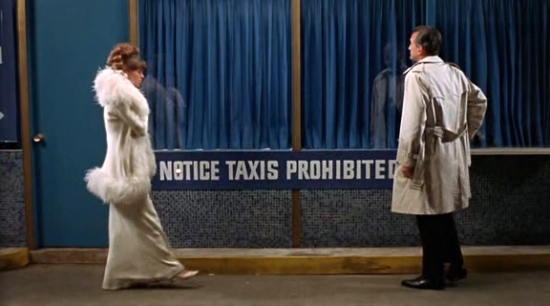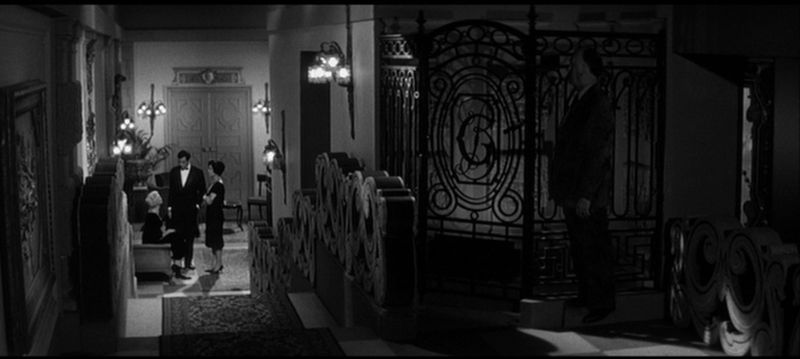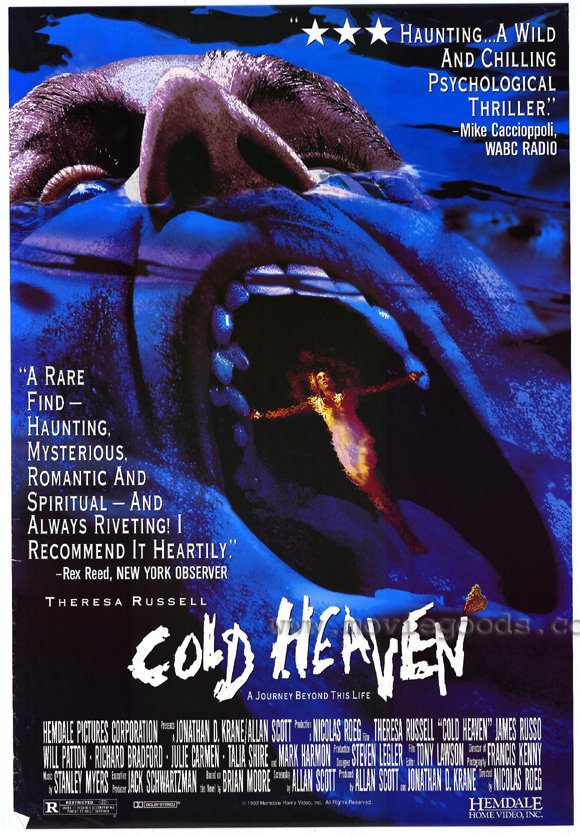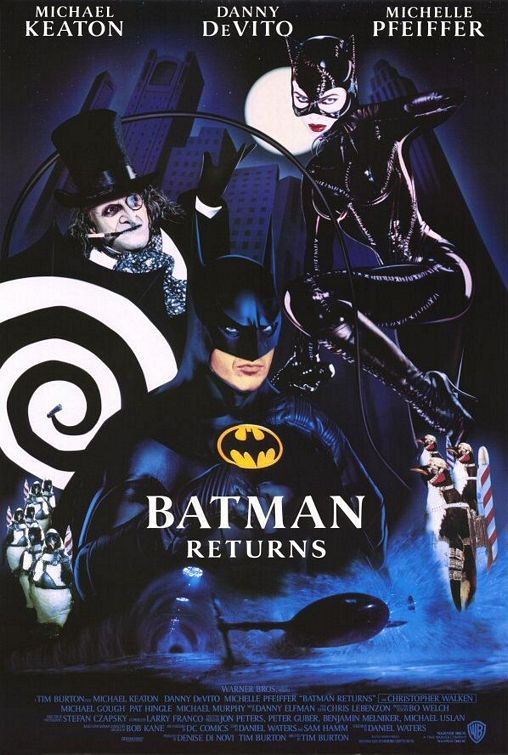From the August 14, 1997 Chicago Reader. — J.R.
COLD HEAVEN
*** (A must-see)
Directed by Nicolas Roeg
Written by Allan Scott
With Theresa Russell, Mark Harmon, James Russo, Talia Shire, Will Patton, Richard Bradford, and Julie Carmen.
The sexy, volatile cinema of Nicolas Roeg might be said to operate under a kind of curse. Born in London in 1928, Roeg entered movies as a clapper boy at the age of 22 but didn’t become a cinematographer until his early 30s. After shooting such interesting films in the 60s as The Masque of the Red Death, Fahrenheit 451, and Petulia, he directed his powerful and still-dangerous Performance (in collaboration with Donald Cammell) in 1968, but then had to wait two years for Warner Brothers to release it.
After Roeg’s first solo directorial effort (Walkabout, 1971) came his first and only commercial hit (Don’t Look Now, 1973). He followed that up with two controversial cult items (The Man Who Fell to Earth, 1976, and Bad Timing: A Sensual Obsession, 1979). In 1982 he made a feature (Eureka) that had a very limited release. Next in line was Insignificance (1985), then another feature with virtually no theatrical life in the United States (Castaway, 1986), then a third limited release (Track 29, 1988).
It seemed that Roeg’s wonderful tenth feature, The Witches (1989), might finally provide him with a second commercial breakthrough, but once again Warner Brothers — clearly in the dark about how to define, package, and market the film — fumbled the assignment. And now Roeg’s 11th feature, Cold Heaven (1991), is arriving in Chicago after being hurriedly dumped in New York and Los Angeles, only because Facets Multimedia had the great idea of giving it a two-week run here.
I’m not claiming that all of Roeg’s movies are masterpieces. I’ve never really warmed to most of Don’t Look Now, actively dislike Bad Timing and Eureka, and have plenty of problems with patches of many of the others, including Cold Heaven. But it’s hard to think of many active filmmakers in the English-speaking world whose styles are as pleasurable, as sophisticated, and as accomplished as Roeg’s — filmmakers whose works breathe and pulsate and vibrate with as much rhythmic energy. Why, then, does his work invariably come to us under a cloud?
To understand, we may have to go all the way back to Richard Lester’s Petulia in 1968, the last fiction feature by someone else on which Roeg worked as cinematographer. In terms of both its form and its achronological editing, it is the first Nicolas Roeg film — jagged yet graceful in its syncopated, nearly subliminal visual rhymes. It’s practically cubist in the way it develops a mosaic around a city (San Francisco), an acute sense of the contemporary, a theme of missed connections, and a relationship. It’s hard to say whether these features mean that Roeg played an uncredited creative role on the film or that he forged his own style and manner out of Petulia (which seems likelier). Either way, this haunting late-60s masterpiece began a kind of cinema that subsequently belonged to Roeg and not to Lester. (After an ambitious and accomplished stretch of features, from A Hard Day’s Night in 1964 to The Bed-Sitting Room in 1969, Lester turned to potboilers and has pretty much continued to make them ever since.)
What was it that blighted Petulia? The fact, one might argue, that it adapted to Hollywood norms the most sophisticated editing style of the 60s, the style of Alain Resnais, and offered it above all as a vehicle for passionate feelings — not fashion, as some insisted at the time. Resnais offered both a potent threat and a challenge to traditional narrative movies in the 60s — and he remains a filmmaker whose influence has never been fully co-opted, domesticated, or absorbed. As a consequence he’s never ceased to be regarded as “pretentious” by this country’s most powerful critical watchdogs. Much of Resnais’ work has literally been banished from our shores, both practically and critically, since the early 80s. It’s as if the commercial success of his highly radical first two features in the early 60s — Hiroshima, Mon Amour and Last Year at Marienbad –frightened our antiintellectual and middlebrow critics so profoundly that they still can’t tolerate any film that even reminds them of Resnais. I’m not saying that Roeg has ever been as good a filmmaker or that his work feeds perpetually on Resnais, either. (It would be more accurate to say that Roeg’s work derives from Petulia and that Petulia derives from early Resnais.) But it does seem that the critical coolness toward every new Roeg picture has been conditioned by long-term hostility toward Resnais and everything Resnais is felt to represent.
I’m far from the first critic to link these two. Indeed, the best piece of Roeg criticism I know — Manny Farber and Patricia Patterson’s “Gothic Lives!” which appeared in Francis Coppola’s short-lived City magazine in 1975 — devotes at least two of its juiciest paragraphs to Roeg’s indebtedness to Resnais’ third feature:
“While the radical Germans were picking up the transsexual banner and facetious attitude from Warhol, it would seem that England’s big three — Losey, Boorman and Roeg — were fastening on Muriel, its princely craftsmanship and Leftist fervor. Talking about the way the French handled themselves in Algeria and World War II, Resnais’ movie about Boulogne, a city split by its bombed past and reconstructed postwar present, shows the marks left on its citizens by the sordid or disillusioning parts they played in two wars.
“The counter-narrative devices of Muriel turn up repeatedly in the baroque British film, particularly the rapid cutting that produces a ripple of shots for each event, the disjunctive soundtrack that is situated at odd angles to the people’s presence, and the feeling of civilized, middle-class people caught in the midst of corruption that set in without their noticing it. Most of all, they respond to a landscape-person synthesis, the effect of people momentarily tied together in a subversive milieu. Terrain, potently present, becomes the main event, and the camera becomes the brains of the operation, the chief weapon for exposing social corrosion in the sterile, plastic L.A. nightmare of shiny office buildings (Boorman’s Point Blank), or corrosion being overturned in Roeg’s three films, where exotic terrain points out the deficiencies in a tidy miss [Walkabout], macho gangster [Performance], and a too sensible architect [Don’t Look Now].”
Written 17 years ago, this is the best description I can find of what Cold Heaven is like.
I’m reluctant to say much about the plot of Cold Heaven for the following reasons:
(1) Plot summaries are almost always boring.
(2) Roeg’s movies are almost never their plots, and the mainstream equation of most movies with their plots tends to build up false expectations and foster various kinds of confusion when it comes to Roeg’s work.
(3) Most plots imply genres, and Roeg’s movies tend to elude generic straitjackets. Performance is a gangster/drug musical, Bad Timing a romantic and psychoanalytic snuff movie, Insignificance a postmodernist historical parable about the 50s, The Witches a comic, scary fairy tale for grown-ups. Cold Heaven starts out as a standard melodrama about adultery, continues as a head-scratching mystery thriller, takes a slow left turn into religious allegory, and winds up as a speculative and highly moral poem about marriage. Trying to squeeze this plot into a genre would almost constitute an act of violence against movie and audience alike. Spectators who climb on board for the melodrama may grudgingly (or gratefully) accept the shift into the thriller mode but then balk at the allegory and poetry, neither of which offers the conventional mystery payoff. Those who come primed for the allegory may get impatient with — or feel insulted by — the melodrama and mystery and/or feel cheated by the poetry, and so on.
(4) I doubt that I could give an accurate plot summary of Cold Heaven even if I wanted to. That’s the film’s charm: for much of its running time, it unveils itself by other means. People who assume that life is only a story or that emotions in movies are only about events are missing one hell of a lot when it comes to both life and movies.
Potential spectators usually want some minimal account of a movie’s plot, however, so here’s a synopsis of the beginning: A wife (Theresa Russell), her lover (James Russo), and her husband (Mark Harmon) are all in Mexico for a medical conference. Just as the woman is about to inform her husband of her infidelity, he is apparently killed in a boating accident. A day later, his body mysteriously disappears from the Mexican hospital. Back in California the wife, irrationally convinced that her husband is still alive, receives an anonymous message to meet someone — husband or lover? — at Carmel, where wife, husband, and lover all stayed some time ago for another medical conference, and where she experienced a sort of religious vision on a cliff not far from a nearby Catholic mission. Although previously she’d ignored the vision because of her lack of faith, she feels obliged to speak to a priest about it after she finds her husband alive in Carmel, though he’s dying from the accident.
An occupational hazard for reviewers is the fact that one can rarely find source novels in print or readily available at the same time the movies are about to open. (New paperback editions are likely to appear, if at all, several weeks after the movies have been released.) Cold Heaven is based on a novel by Brian Moore, but all I know about it I found out from a friend in Los Angeles who saw the film several months ago and managed to find the novel. He told me that the movie’s ending is completely different, and that many of the other details are also substantially different. It sounds as if the story has been rethought and refurbished; the fact that the screenwriter and producer, Allan Scott (who also wrote and produced Don’t Look Now, Castaway, and The Witches), is a devout Catholic may or may not be related to these changes.
Even this skeletal summary hints at themes and a plot ripe for pretentious treatment. But one sorely needs a sense of proportion, missing from most accounts of Roeg’s career, about what is pretentious and what is not. After all, a Catholic mission and resurrection were also given joint treatment in Vertigo, a film not often accused of pretension. (Another intriguing cross-reference, suggested by my colleague Bill Krohn, is Rossellini’s Stromboli.)
The charges of pretension that have been made against Resnais since the 60s and against Roeg since the 70s are basically predicated on a taste for “unpretentious” Hollywood entertainment over more ambitious, “serious” European fare. Of course, this xenophobic bias causes critics to overlook the fact that much of Resnais’ Marienbad is a sidesplitting parody of Hollywood glamor and intrigue, from Gilda to Hitchcock and Sternberg. Then there’s the fact that the notion of European movies being more pretentious than American movies is completely out of date. Just take a look at the extremely pretentious American art movies of the late 70s — movies like The Deer Hunter, Apocalypse Now, Interiors, and Close Encounters of the Third Kind, which were taken with a straight face by many of the same critics who hooted at Resnais and Roeg. If there’s a truly pretentious and overblown art movie playing in Chicago now, it’s Batman Returns, not Cold Heaven. And though some may find the content in the Roeg movie “heavy,” what makes it pleasurable for me is the grace and fleetness of the style — fully present in both the direction of the actors and the framing and arrangement of shots. Tim Burton seems like a lumbering elephant by comparison.


